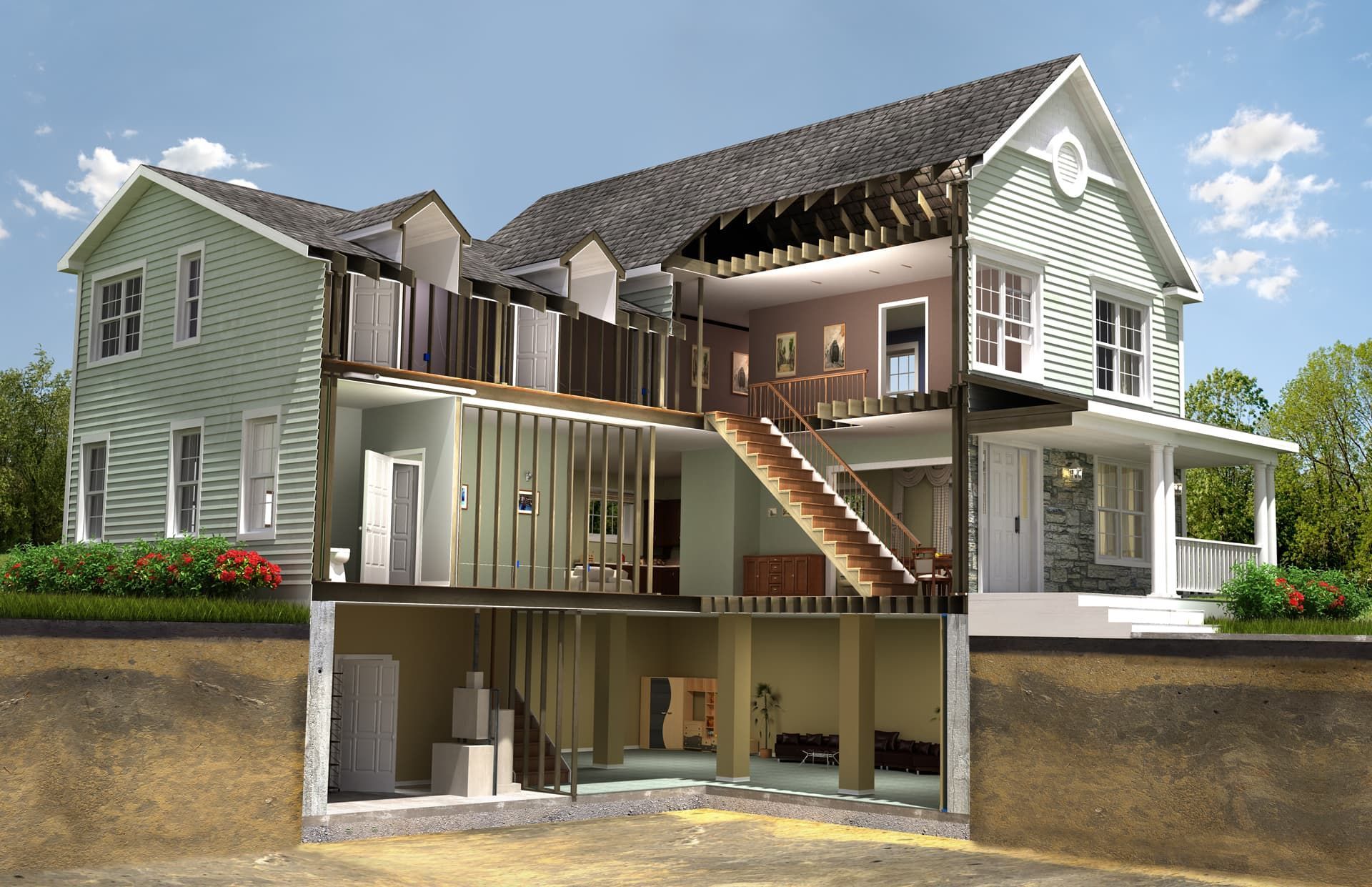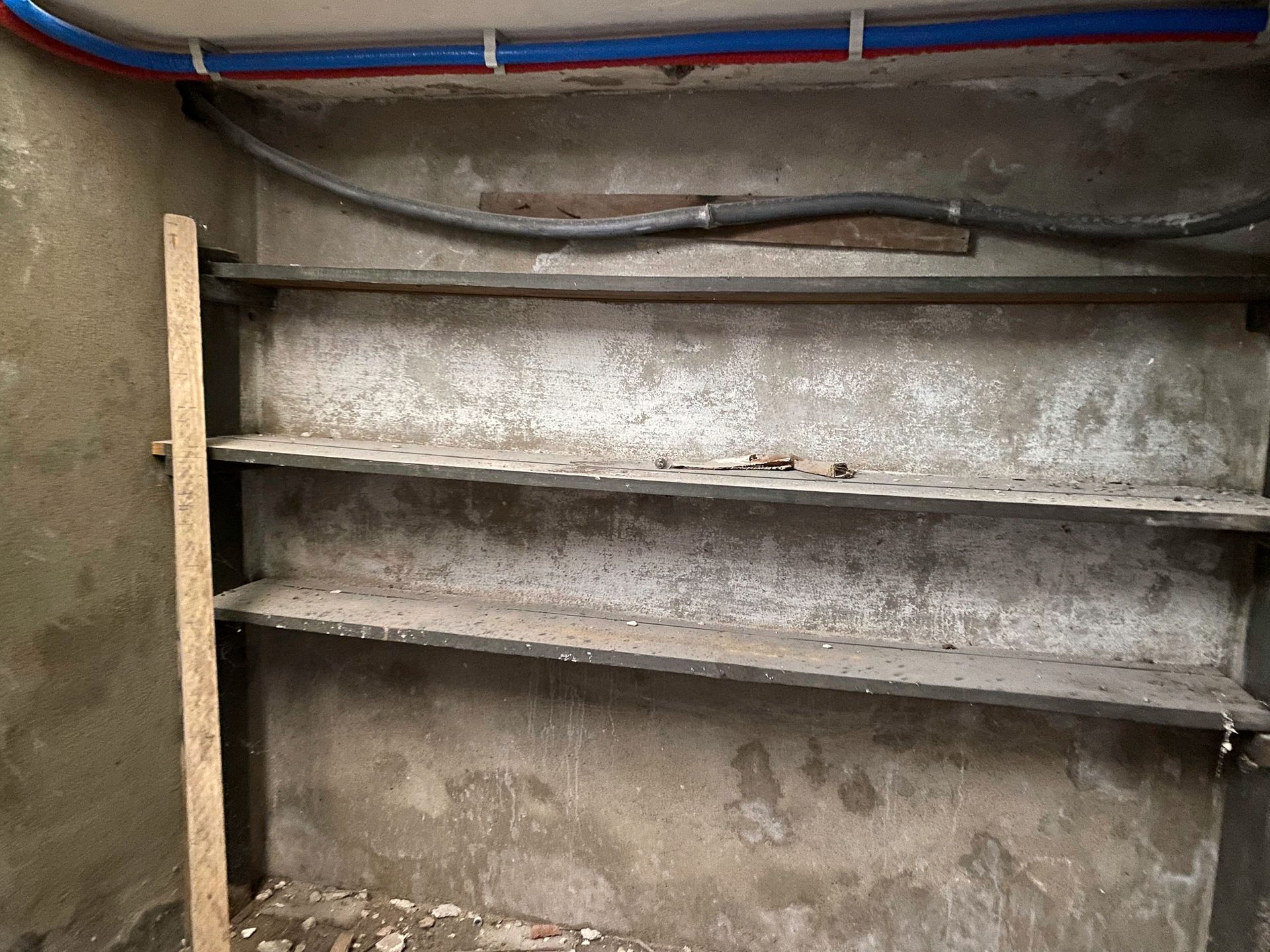How to Fix Bowing Basement Walls: Top Repair Methods Explained
Need to know how to fix bowing basement walls? This article will show you how to assess the issue and guide you through proven methods to repair and stabilize your basement walls. Bowing walls are a serious problem, but with the right approach, you can prevent further damage and ensure your home’s stability. Continue reading to discover the best solutions and techniques for fixing bowing basement walls.
Key Takeaways
- Bowing basement walls are caused by external pressures such as hydrostatic pressure, soil expansion and contraction, and poor drainage systems, leading to inwardly curved walls and structural damage.
- Effective repair methods for bowing basement walls include carbon fiber straps for minor bowing, wall anchors, steel I-beams, and helical tieback anchors for more severe cases, each method tailored to specific conditions and severity.
- Preventive measures such as proper drainage systems, regular foundation inspections, and maintaining consistent soil moisture levels are critical for avoiding future bowing of basement walls and ensuring long-term structural stability.
Understanding Bowing Basement Walls
Bowing basement walls are a clear indication that external pressures are pushing against the walls of your foundation, causing them to curve inward. These are also known as bowing foundation walls, a term that underscores the critical nature of the problem. Recognizing the signs early on is key to preventing further damage. Common indicators include an inward curve, horizontal cracks, and stair-step cracks in the mortar between blocks, all of which can be observed in a bowing basement wall.
Horizontal cracks often follow a long, horizontal pattern across the wall, while stair-step cracks typically appear in the mortar joints of block walls. If these signs are evident, ascertaining the degree of the bowing becomes crucial. A convenient way to do this is by using a plumb line. By dropping a plumb line from the top of the wall to its base, you can see if the line falls outside the wall’s center of gravity at the base, which is a strong indication that the wall is bowing.
Recognizing these signs and acting promptly to repair bowing walls can prevent further structural complications. We will now examine the root causes of these bowing walls.

Causes of Bowing Basement Walls
Several factors can contribute to bowing basement walls, each exerting pressure on your foundation in different ways. Hydrostatic pressure, soil expansion and contraction, and poor drainage systems are among the primary culprits.
Comprehending these causes will aid in taking preventative steps and selecting the most efficient repair methods. We will now delve into each cause in further detail.
Hydrostatic Pressure
Hydrostatic pressure occurs when the soil around your foundation becomes fully saturated with water. This pressure can push against basement walls, causing them to bow inward. As water accumulates in the soil, hydrostatic pressure increases, exerting significant lateral pressure on the walls.
Rising water tables can intensify this issue, exerting additional pressure on the walls. It’s vital to manage hydrostatic pressure to uphold the structural soundness of your basement walls.
Soil Expansion and Contraction
Soil expansion and contraction are primarily driven by changes in moisture levels. Expansive soil, which contains a high amount of clay, can swell significantly when it absorbs water, pushing against basement walls. Conversely, during dry conditions, the soil shrinks, pulling away from the foundation and creating gaps.
Such persistent alterations in soil moisture levels impose extra stress on basement walls, triggering bowing. Regulating consistent soil moisture levels is paramount to averting these fluctuations and safeguarding your foundation.
Poor Drainage Systems
Poor drainage systems can significantly contribute to the bowing of basement walls. When water isn’t properly directed away from your foundation, it can lead to excessive soil saturation and increased pressure on the walls. This can result in further damage and exacerbate existing issues.
Correct grading around the foundation coupled with efficient drainage systems like French drains and gutter extensions, aid in diverting water away from the structure, minimizing hydrostatic pressure and warding off structural damage.
Methods to Fix Bowing Basement Walls
Fixing bowing basement walls involves several methods, each suited to different degrees of bowing and specific circumstances. Some common methods include:
- Carbon fiber straps
- Helical tieback anchors
- Wall anchors
- Reinforcing steel beams
The goal is to stabilize and secure the concrete walls, including the foundation wall, to prevent further deterioration.
We will now discuss these repair methods in further detail.
Carbon Fiber Straps
Carbon fiber straps are a highly effective solution for minor bowing (less than two inches). These extremely strong fabric materials are bonded to the wall with epoxy, providing a robust reinforcement that prevents further movement. The installation process is quick and minimally invasive, as it can be done from the inside of the basement without the need for excavation.
Typically placed every four feet along the length of the wall, carbon fiber straps distribute the reinforcing effect evenly, ensuring that the wall remains stable. Due to its cost-effectiveness and efficiency, this method is a preferred choice for many homeowners.
Wall Anchors
For walls bowing more than two inches, wall anchors are the recommended solution. These wall plate anchors stabilize basement walls by distributing the pressure into the yard, preventing further bowing. The installation process involves attaching a steel plate to the basement wall and burying another plate (the anchor) in the yard. The two pieces are connected with a steel shaft. This creates a strong and secure bond between them.
As the steel rod is tightened, it draws the basement wall towards the anchor in the yard, providing stability to the wall. Both poured concrete and block foundation walls are amenable to this method, with anchors ideally placed every five feet along the bowing wall for uniform support.
Steel I-Beams
Steel I-beams are used in cases of severe wall bowing where other methods may not be sufficient. These beams are strategically positioned vertically along the length of the wall, spaced at intervals of about four feet. They are locked in place with concrete footings and reinforcement brackets, providing robust support for the wall.
Steel I-beams distribute loads evenly, preventing further bowing and ensuring the structural integrity of the basement walls. This method is minimally invasive and offers a long-lasting solution for heavily bowed walls.
Helical Tieback Anchors
Helical tieback anchors are ideal for deep stabilization of significantly bowed walls. These long screws with helical plates are drilled through the earth and secured to the inside of the basement wall, creating a horizontal anchor point. The installation involves driving a steel post with helical blades into the earth outside the foundation and securing it to the basement wall with a large steel plate.
This method is the least intrusive and most invisible, as it does not disrupt the outdoor ground. Helical tieback anchors are particularly useful when the wall is bowing more than two inches, and other methods are not feasible due to property arrangement.

Preventing Future Bowing
To forestall future bowing of basement walls, proactive steps are necessary to control soil moisture and alleviate pressure on the foundation. Key strategies include the installation of appropriate drainage systems, regular foundation inspections, and the maintenance of consistent soil moisture.
These preventive actions serve not only to shield your foundation but also to save you from expensive repairs down the road. We will now examine each of these methods in further detail.
Installing Proper Drainage Systems
Effective drainage systems are crucial for preventing water accumulation around your foundation. By providing a pathway for water to flow away, these systems reduce hydrostatic pressure on basement walls. Gutters and downspouts that are not properly maintained can lead to pooling water around the foundation, increasing the risk of wall bowing.
French drains and gutter extensions are effective solutions for directing water away from the foundation, thereby reducing soil moisture levels and pressure.
Regular Foundation Inspections
Regular foundation inspections are vital to detect early signs of damage and prevent larger issues. Scheduling annual inspections can help identify problems before they exacerbate, ensuring the stability of your foundation. Professional inspections typically include checking for cracks, moisture levels, and wall alignment.
By catching these issues early, you can take timely action to repair and stabilize the foundation, avoiding more significant structural damage down the line.
Maintaining Consistent Soil Moisture
For the prevention of swift changes that stress basement walls, it is crucial to maintain uniform soil moisture around your foundation. Fluctuations in temperature can induce soil expansion and contraction, thus causing structural stress. The usage of soaker hoses and drip irrigation systems can aid in maintaining balanced soil moisture levels, thereby preventing such fluctuations.
Mulching around the foundation also helps in retaining soil moisture and preventing rapid changes, which can protect your basement walls from bowing.
Why Timely Repair Is Crucial
Prompt repair of bowing basement walls is vital to avoid severe structural damage and potential wall collapse. Bowed foundation walls signify considerable pressure on the foundation, and if overlooked, can lead to serious problems like cracks, leaks, and even a bowed wall collapse. Neglecting these issues can culminate in more comprehensive and expensive repairs down the line.
Identifying and addressing bowed basement walls early can help stabilize the structure and minimize the repair intrusiveness. The average costs for repairing bowing basement walls range between $6950-$8300, influenced by the extent of bowing and external conditions.

The Basement Ace: Your Partner in Foundation Repair
The Basement Ace specializes in foundation repair, stabilization, and waterproofing, offering a comprehensive range of services to protect your home. From foundation crack repair to sump pump systems and mold remediation, The Basement Ace combines innovative techniques with robust materials for long-term protection.
Their bespoke consultation process includes meticulous inspections with state-of-the-art technology to comprehend your home’s needs and provide custom solutions. Rely on The Basement Ace to reinforce your foundation and guarantee your home’s safety.
Contact Us for a Free Estimate
For a free estimate and professional support, contact The Basement Ace today. Their experienced team will provide permanent solutions for your bowed basement walls, ensuring your home’s stability and safety.
Summary
Understanding the causes and repair methods for bowing basement walls is crucial for maintaining the structural integrity of your home. From hydrostatic pressure and soil expansion to poor drainage systems, various factors can contribute to wall bowing. Effective repair methods like carbon fiber straps, wall anchors, steel I-beams, and helical tieback anchors can stabilize and secure your walls.
Preventive measures such as proper drainage systems, regular foundation inspections, and maintaining consistent soil moisture are essential to avoid future issues. Trust The Basement Ace for expert foundation repair and stabilization services to keep your home safe and secure.
Frequently Asked Questions
What are the signs that a foundation needs repair?
If you notice cracks in walls or flooring, sticking doors or windows, uneven floors, gaps around window frames, or water intrusion in the basement, these are signs that your foundation may need repair. Addressing these signs promptly can help prevent further damage.
What causes bowing basement walls?
Factors such as hydrostatic pressure, soil movement, inadequate drainage, foundation settling, tree roots, and construction quality issues can cause basement walls to bow inward.
How effective are carbon fiber straps for repairing bowing walls?
Carbon fiber straps are highly effective for stabilizing minor bowing walls, providing strong reinforcement and preventing further movement. They are minimally invasive and cost-effective, making them a great option for minor bowing issues.
Why is timely repair of bowing basement walls important?
Timely repair of bowing basement walls is important because it prevents significant structural damage, potential wall collapse, and increased repair costs. Addressing the issue early helps stabilize the structure and minimize repair intrusiveness.
What services does The Basement Ace offer?
The Basement Ace offers foundation repair, stabilization, waterproofing, sump pump systems, crawl space solutions, air quality control, and mold remediation services.

All Rights Reserved | The Basement Ace (Formerly Basement Authorities NH)

